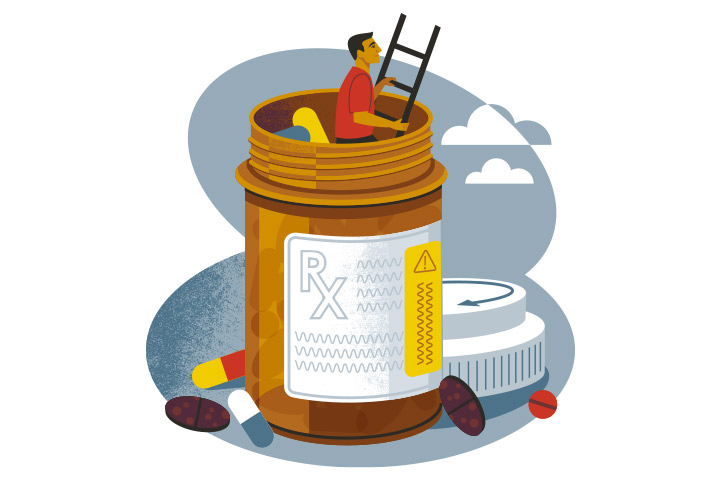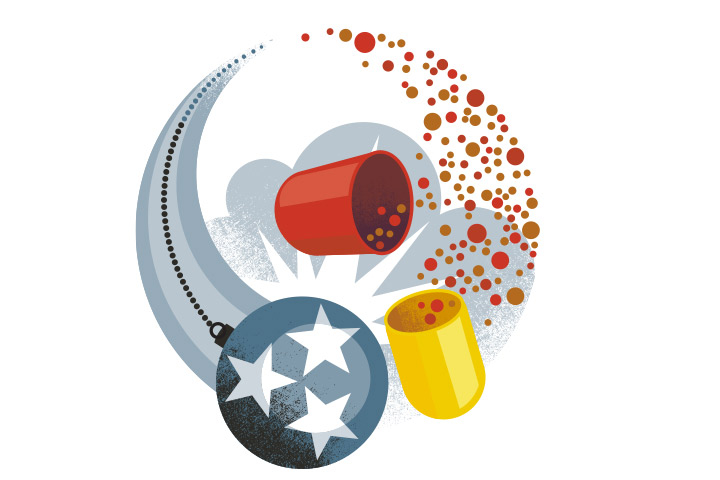Drug overdoses are now the leading cause of death for Americans ages 18-45.
The pandemic predictably made things worse. From 2019 to 2020, the rate of overdose deaths increased by 48 percent, and in the 12-month period ending in May 2022, the crisis claimed the lives of more than 3,800 people in Tennessee alone. On top of this alarming death rate, the economic impact has been similarly severe, now costing the state of Tennessee over $2 billion annually.
Witnessing how drug abuse and overdoses were taking a toll on the state and its communities, in 2020 UT System President Randy Boyd launched the Substance Misuse and Addiction Resource for Tennessee (SMART) initiative to assist the state in addressing this Grand Challenge. The SMART initiative aims to reduce overdose deaths in Tennessee by educating people; developing, initiating and evaluating research-based programs; and securing additional federal funding for state and local initiatives.
“The epidemic around substance abuse is one of the most pressing challenges that faces Tennessee. It’s something I’ve heard from government officials, business owners and law enforcement as I have travelled the state,” Boyd says. “No one can solve this problem alone. It’s going to take an educated approach with many public-health experts, government and organizations collaborating together. I’m proud that experts from across UT and Tennessee are working to untangle this complicated web through SMART.”
In early 2022, SMART became a part of the UT Institute for Public Service, the university’s source of outreach for Tennessee’s public-service sector.

Since that time, SMART has grown in scope, seeking to empower communities and local governments through education. SMART has published numerous policy briefs, articles and podcast episodes on issues related to substance-use disorder and hosted several workshops and educational sessions. Working with experts in health care, criminal justice, government and other fields directly impacted by the overdose crisis, SMART has become a repository of data and analysis that can be used to develop evidence-based policy. SMART maintains numerous interactive data dashboards that display county-specific information on morbidity, mortality, prescription rates, community resource locators and much more.
“Educating ourselves and our communities about these issues is critical,” says Jennifer Tourville, executive director of the SMART initiative. “This is a rapidly changing problem, and we must stay up to date with the current trends so we can continue to modify and refine how we’re responding to these problems based on the shifting needs of the state. We want to work with counties and cities directly to help them implement community-based programs, evaluate those programs to determine their effectiveness and then replicate what works.”
Although this challenge is called the opioid crisis—and it is synthetic opioids involved in the vast majority of all drug-related fatalities—it is more accurate to think of this as a polydrug crisis, where it is a combination of many kinds of substances contributing to rising overdose deaths.

Fentanyl has become so widespread that it is being found contaminating illicit drugs including methamphetamine, cocaine, benzodiazepines and even some cannabis products. Fentanyl has also been found pressed into counterfeit pills or disguised as candy. Many people overdose without ever realizing they are ingesting an opioid or a drug exponentially more potent than they thought.
Dr. Stephen Loyd (Knoxville ’89), a member of the SMART steering committee, says he believes the opioid crisis is the biggest problem the state faces.

“It is the only problem I know of that has a negative impact on all services that are state-based, not the least of which is the Department of Corrections, Child Protective Services, TennCare and workforce development. … Everything is impacted,” Loyd says.
In addition to his involvement with SMART, Loyd serves as the chief medical officer for Cedar Recovery, vice president of the Tennessee Board of Medical Examiners and chairman of the Tennessee Opioid Abatement Council. He also knows firsthand the negative effects of opioids, as he has been in long-term recovery from opioid and benzodiazepine addiction since 2004.
For several years now, Loyd has been one of Tennessee’s most important authorities on all matters related to addiction.
A lot has changed since the prescription opioid phase of the 1990s and early 2000s, when people like Loyd developed opioid addictions from legal prescription drugs such as OxyContin. Thanks to years of activism and lawsuits, rates of prescription opioids have declined by over 35 percent, and overdose deaths involving prescription opioids have steadily and modestly decreased over the last several years.
But overall overdose deaths continue to climb, thanks to fentanyl.
Loyd says 3,032 Tennesseans died in 2021.
“When I started doing my job in Nashville in 2015, the number was 1,011. That’s one person short of being exactly three times. The problem is now so complicated that there will never be a silver-bullet solution. Fixing prescribing laws may have helped close pill mills, but this does little for people that overdose on meth contaminated by fentanyl,” he says.
There is hope, though. Experts have learned about what works and what doesn’t. It’s just a matter of getting people the access to those interventions.
“That’s what is so great about what the SMART initiative does,” Loyd says. “It’s giving data-based input on potential policy that can move the needle. You can have programs that work and have good outcomes, but if there are barriers standing in the way from a policy perspective, you need to make a data-informed, community-based decision to make those programs happen.”
In the summer of 2022, SMART hosted a criminal-justice summit for over 90 county mayors, sheriffs, program officials and other key stakeholders in the East Tennessee region to discuss prevention programs, treatments in jail and housing initiatives that have been effective.
In response to the rise of fentanyl and polydrug use, positive changes have been implemented with good results. Telehealth regulations have expanded, significantly increasing access to mental health and addiction treatment. Overdose-reversing naloxone (often known as Narcan) has become more accessible and available than ever. Syringe service programs (SSPs) have opened, reducing the incidence of HIV and hepatitis and connecting people to treatment (studies show that people who go to SSPs are five times more likely to enter long-term recovery). SSPs provide access to and disposal of syringes, testing and substance abuse treatment. More drug courts have opened, and incarceration alternatives have been implemented, meaning there are more people in treatment who would have otherwise just been in jail. Faith organizations have become involved, such as a church in Claiborne County that operates a SSP and recovery program. More schools require that teachers learn mental-health first aid.
Most of this occurred only in the last five years, and new treatments, strategies and programs are being developed all the time.
“I call Jennifer a lot,” Loyd says. “I run into things that I don’t know anything about, and she gives me good direction. Being able to just call members of the initiative, the way they use data and their experience just helps guide me in the things that I need to do. With all that SMART has done, I think it’s going to give us a real chance here when it comes to spending the opioid abatement money wisely.”
Due to the lawsuit settlements by opioid manufacturers for wantonly pushing the pills, Tennessee officials are determining how to spend the money to abate the crisis.

Now housed in the UT Institute for Public Service, which has long-standing relationships with all 95 counties, SMART is quickly becoming an integral part of helping the state address this complex and multi-faceted epidemic.
“This community-specific approach will be paramount to the success of these efforts, as what works in one community may not work in another,” Tourville says. “There are a lot of moving parts to this complex challenge.”
But it all begins at one place.
“I think it starts with harm reduction,” says Loyd. “You have to keep your patient alive at first, and then we can look into helping them improve their lives, whether it be, you know, a GED, higher education, job training … taking the steps toward the long-term rewards of recovery. Getting your family back, becoming a tax-paying resident of our state.”
This is a problem that everyone can help fix.
“This is something we can all do together,” Loyd says. “People just need to view addiction as a treatable medical condition. That’s the first step. It’s a treatable disease that we have life-saving medication for. Prevention is the other ingredient, especially for young people. We have to do more outreach and prevention programs to stop addiction before it starts, and that begins with just talking to people openly and honestly about the realities of this disease.”
At smart.tennessee.edu, learn about harm reduction, tele-health, criminal justice reform, medications for opioid use disorder and other topics related to this treatable medical disease. The more the haze of stigma is reduced, the better treatment can expand and healing can begin.



